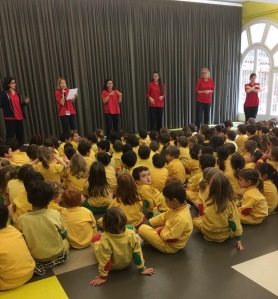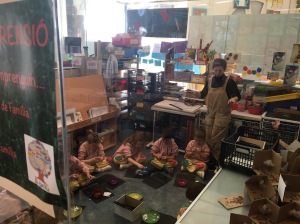On Friday 5 May, I had the great privilege to visit Col~Legi Montserrat in Barcelona. This school is one of ten led by Missionary Daughters of the Holy Family of Nazareth. They have four of schools in Barcelona, four in the Canary Islands and two in Madrid. Their founder, St Josep Manyamet was proclaimed a saint of the Catholic Church in 2004.
Col~Legi Montserrat provides learning for 1 year old children through to 18 year olds adults, all on the one campus pearched high on the hill overlooking Barcelona. Each ‘year group’ has 60 students with 2 or 3 teachers and hours are 9am to 5pm, Monday to Friday. They have a two hour break at 1pm where they have lunch, play and engage in extra curricular activities, everyday.
For preschool (1-5 year olds), the start of each day begins with 30 minutes of prayer, story and play based learning. The story for each day focuses on faith, a value or context based on a theme for the week/fortnight. For example, the 5 May story related to Mothers’ Day. Questions were asked about the characteristics of mothers and then a song was sung and danced by the students. This happens each and every day.

At the end of the 30 minutes, those students move off with their teachers. I witnessed 2 year olds, all still learning to talk, start the day by taking the roll. Each student learning to pronounce the name of another as the teacher reads the roll. For 30 minutes, 3 year olds engaged with flash cards containing letters, visuals, cartoon pictures and landscapes where students were asked to name the image. Images chop and change quickly. This happens everyday.
Moving from one room to another, I witnessed Year 1 have an open and transparent discussion about a child who was crying earlier that morning. The conversation took place in Catalan, the language of Barcelonians, but Sister Monika interpreted,
“One child said they noticed another student crying and asked why. The teacher then asked that child, ‘What happened?’ The child talked about how their parents upset them at home that morning.”
Instead of a discussion with the principal about mandatory reporting, the teacher named the feelings of anger and hurt. Empathy and understanding can be a focus at any given point as a part of ‘just in time learning’. Without hesitation, the class moved onto the next activity which was counting.
The whole school learning approach is based on updated and ongoing research about multiple intelligences and learning styles. As such, educating students to speak, read and write involves ‘the whole body’ multiple times throughout the day. In the video which follows, 4 years olds are ‘reading with their body’. One gesture relates to both a sound and a word. As Sister Monika said,
“It is a playful, game based way to learn to read.”
There is a also a strong commitment to the arts as a part of catering for and educating the whole child. For example, commencing in Kindergarten, there is the commitment for a specialist art teacher to work with children to learn specialist art language and apply that language across class projects within mainstream learning.

Also, all 3 to 5 year olds are withdrawn once a week to learn to play the violin. Wow!
Col~Legi Montserrat is not a new school school. It is a big brick building set on the side of a hill. It is 5 stories high and also has a more modern looking second building which is their separate senior secondary school for Year 11 & 12. Upon my arrival I mistook this part of the school for the preschool. It is bright, modern and playful – for 17 & 18 year olds! Anyhow… To invigorate the ‘old’ building, the staff have turned their corridors and stairwells into learning showcases and display spaces. When travelling between classrooms and observing the showcases I observed and heard from Sister Monika about the following:
- A Year 1 project which started with the question, “Do you think your journal is suitable?” The question centred around their daily timetable, its operation and its appearance, whether it suited their needs. In responding to this lead question, students interviewed their parents about how they used their time across the week and, as a part of this, they had to learn about minutes and hours in each day. Learn the days of week, heard about times of the day by interviewing parents and grandparents.
- Integration is a big part of their work, most especially in the secondary area. Rarely is a subject taught in isolation. In some cases there are 2 or 3 subjects combined, and those subjects change across year groups and within the year. There is an agility to the learning in so many aspects of the day, week, month and terms. Furthermore, for each secondary school project, there is an aspect of service learning, faith context or outreach commitment added to the project where students ask,
“How can our project, our product, our idea help others?”
- Year 10 has two hours on entrepreneurship every week. Recently, small groups of Year 10 created a real company based on a social need. It commenced with an empathic investigation by looking at ‘needs’ near and far. One group design a fashion bracelet that acted as a tracking device for those seniors who occasionally wander from their nursing home.
- 20 years ago, the school developed its own mathematics program for 3-12 year olds. It was heavily scaffolded with high energy activities with actual book work equalling 10 minutes out of a daily one hour commitment to mathematics. The other 50 minutes is made up of play based, ‘whole body’ activities. This same program is now present in 700 schools across Spain.
- In primary, through to Year 8, each child has Coding & Robotics for one hour a week. The ‘subject’ is delivered by a technology specialist teacher who delivers each and every lesson ‘in English’, as is the case for drama & film for Year 7 to 10.
- Preschool, Primary & secondary classrooms seamlessly flow from one into another. There is no clear division.
- A few years back teachers asked, “Can we knock the walls down?” So they did!
- The whole time I was there I never heard a bell. As Sister Monika said,
-
“We don’t use bells in the real world. I think the bells are more for the teachers. We haven’t used them for years.”
There is only so much you can get to know about a school in a day. Like any other school, I am sure that Col~Legi Montserrat is not perfect. I am sure there have been mistakes made along the way, Sister Monika said there have been many. However, it was a privilege to witness a creative school with a commitment to innovation – a school which is committed to being the best learning community it can be and one which has students at the centre, working collaboratively and driving their own learning.
Greg

Thanks Greg for sharing your visit. The community and students must be so happy with the way this school is working with the children, The way they start the day is so welcoming and with a real purpose and the integration for secondary school. I like this line “We don’t use bells in the real world. I think the bells are more for the teachers. We haven’t used them for years.”.A great read, as we head into NAPLAN week… Thanks and enjoy your trip 🙂
Really enjoying your blogs Greg on your visits. The seamless flow between the stage sounds great and I’d love to know how they take advantage of that from a learning approach lens. Thanks again for your insights.